Ultius Blog
A Look Inside the Growing Problem of Opioid Addiction in the United States
The United States is currently in the middle of a crisis regarding opioid addiction. Nora D. Volkow, writing for the National Institute on Drug Abuse, has indicated that as of the year 2012, there were a total of about 2.1 million Americans were abusing prescription opioids, and that another 467,000 were addicted to heroin. These numbers are startling, and indicate that opioid addiction should be treated as a serious problem affecting the health of many people within the nation.
The term opioids refers to a range of drugs that share a common chemical origin and exhibit common properties. These drugs include opium, morphine, oxycontin, and heroin. The abuse of these drugs results in approximately 30,000 American deaths a year. These drugs are deadly when abused and overdose deaths from them outnumber street drugs, including heroin. Heroin itself leads to more overdoses than any other class of street drug in the recreational drug culture of America. In 2014 there were over 10,000 heroin overdose deaths, and more than 20,000 deaths from prescription opioids in the United States, according to drugabuse.gov.
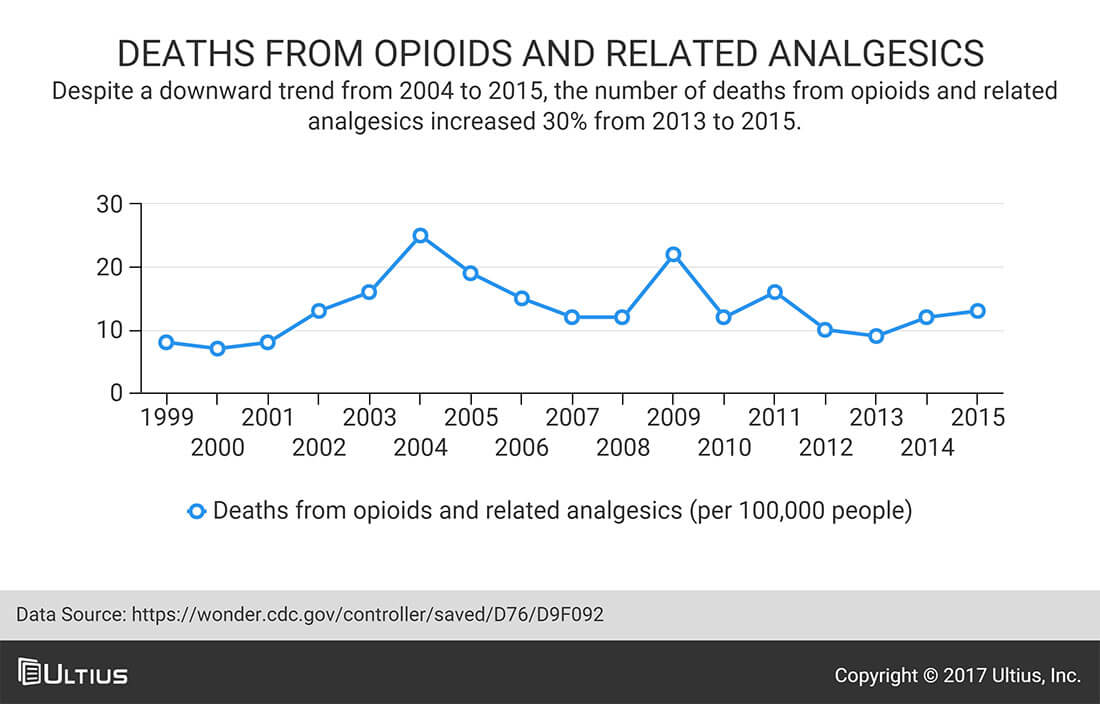
The history of opioids
Opioids are a class of drugs that are prescribed primarily for pain relief. A side effect—a feeling of euphoria is what tends to lead to opioids being abused. Opioids have a very long history. This is because opium is derived from the poppy plant, which was known to people of ancient civilizations. Purdue Pharma, in an article published by The Atlantic, has indicated that the first reference to opium cultivation can be found as far back as the year 3400 BC, in Mesopotamia.

Purdue Pharma has also developed a helpful time line regarding the history of opioids across human civilization. Given that this was created by a pharmaceutical company, there is reason to suspect bias; however, it would seem that the basic facts of the time line are in fact objectively accurate, if not the value and interpretation ascribed to each fact.
| Year | Development |
| 3400 BC | Cultivation of opium in Mesopotamia |
| c. 400 BC | The great Greek physician Hippocrates recognizes the medicinal value of opium |
| 1100s-1400s | As a result of the Catholic Inquisition, opium is condemned in the West, being seen as a product of the East and thus the Devil |
| 1527 | The Swiss-German alchemist Paracelsus invents laudanum, which was found to be very effect at reducing pain |
| 1806 | German scientist Sertüner isolates a drug from opium; names it morphine, after Morpheus—the god of dreams |
| 1800s | Morphine regularly used for pain treatment and especially surgical procedures |
| 1909 | American Congress bans opium for smoking: the beginning of the War on Drugs |
| 1916 | German scientists synthesize oxycodone |
| 1924 | Heroin made illegal for all purposes within the United States |
| 1950 | Oxycodone approved for medical use by the Food and Drug Administration (FDA) |
| 1960s-1970s | Addiction to opioids in America grows, as does governmental crackdown on the use of opioids |
| 1980s | "Opiophobia:" physicians become reluctant to prescribe opioids to patients |
| 1990s | Landscape changes: greater sensitivity to the problem of pain leads to dramatic rises in prescription of opioids |
| 2000s | Opioid addiction grows |
| 2010 to present | Some technical efforts being taken to make opioids more difficult to abuse |
Different motivators
Opioids have a long history of use by human beings, starting with the cultivation of opium from the poppy plant over five millennia ago. When Chinese immigrants began settling in San Francisco during the California gold rush, they brought opium with them.
Opium dens were common refuges for the Chinese workers, who were largely overworked, and essentially treated like slaves. Americans looking for a thrill, or an escape also began to frequent these opium dens, essentially kick-starting opium abuse in the United States. Opium dens were the basis behind the first ever anti-drug law passed in America, the 1875 ordinance banning opium dens.
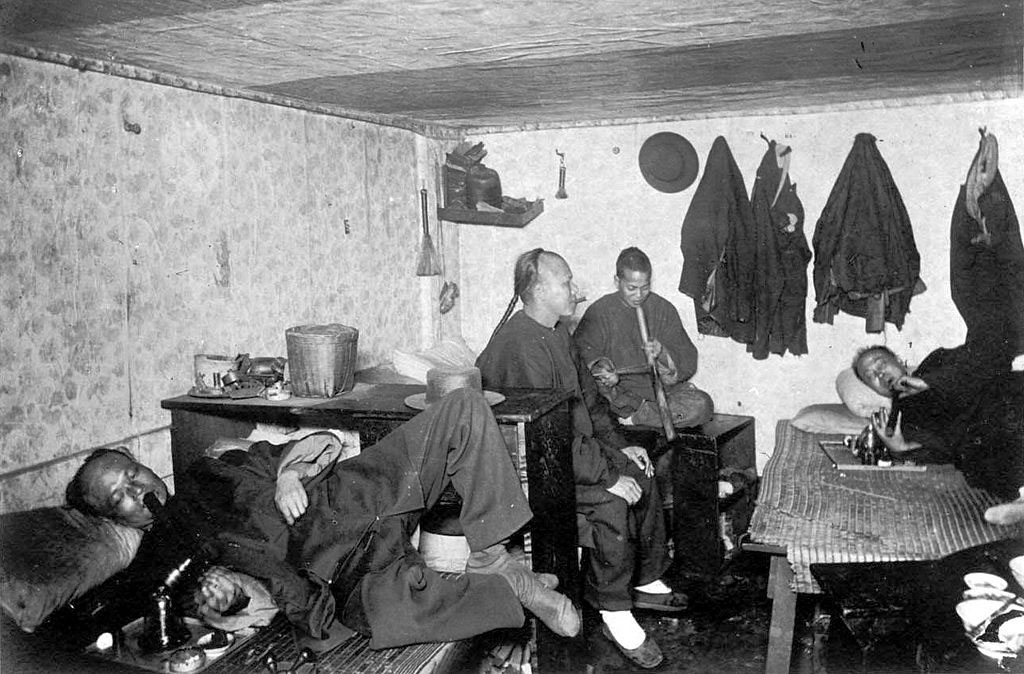
Over time, with greater general acceptance of opioids, they began to be prescribed for the treatment of pain within the United States. Also, this general acceptance greatly increased the rates of the non-medical modern trend abuse of opioids by Americans.
On one hand, both pharmaceutical companies and physicians may have vested interests in improving public perceptions regarding opioids. Usually, these interests are motivated by profit. On the other hand, ordinary people often find themselves caught in the throes of addiction. These people find pleasure, and the above-mentioned euphoria from the narcotic effects of opioids, and thus feel drawn to abusing them.
Areas significantly affected by opioid addiction
The opioid abuse crisis within the United States is not demographically distributed in an even way. Rather, there are clearly some communities within the nation that have been affected by it in a far more significant way than other communities. In general, it would seem that rural areas have been hit much harder than urban areas by the opioid abuse epidemic.
Katherine M. Keyes et al., in an article published in the American Journal of Published Health in the year 2014, have indicated the following:
"Although all states have demonstrated an increase in nonmedical prescription opioid morbidity and mortality during the past decade, death and injury from nonmedical prescription opioid misuse are concentrated in states with large rural populations, such as Kentucky, West Virginia, Alaska, and Oklahoma."
So, while the problem is a national one, it is also clearly more concentrated in some regions than it is in others.
A broader drug issue
The numbers indicate that the heavier concentration of opioid abuse in rural areas may be related to a broader trend of more prevalent drug abuse in those rural areas. In particular, it would seem that rural folk are less likely to seek treatment for drug abuse on their own initiative than urban folk.
One example, in a study of drug abuse clinics, the Substance Abuse and Mental Health Services Administration (SAMHSA) has indicated that 51.6 percent of rural populations were referred by the criminal justice system, compared with just 28.4 percent of urban populations.
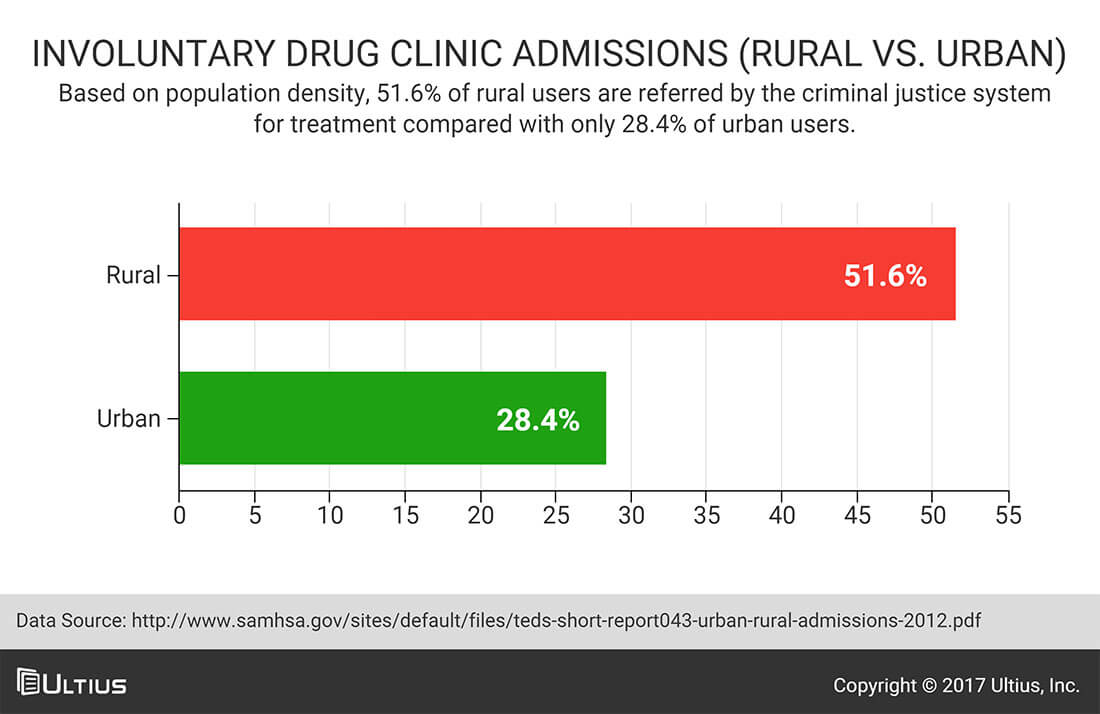
This points toward a stark cultural difference regarding drug abuse that may underlie the disparity in opioid abuse rates. However, it may also be necessary to seek a deeper reason why this difference exists in the first place.
The problem of despair
It is a general principle that people may turn to drug abuse, including opioid abuse, when they are feeling depressed or hopeless about their lives. With this in mind, it is worth turning attention to recent statistics regarding economic significance and voter preference in the 2016 American presidential election.
According to Jim Tankersley of the Washington Post, Hillary Clinton won about 500 counties within the nation that generate 64 percent of economic activity within the nation; whereas Donald Trump won about 2,600 counties that generate the other 36 percent of the economic activity with the nation. The following charts will graphically demonstrate the dramatic disparities inherent in these numbers.

These charts indicate that more than four-fifths of the counties of the nation generate just a little more than one-third of the economic activity of the nation. Moreover, these counties would seem to be concentrated in the heartland of the nation, in the large rural areas that heavily went for Trump in the recent presidential election.
This is relevant to the present discussion on opioid abuse, because it indicates that the American economy has by and large left rural people and communities behind. This can make it difficult for such people to dream about a better life or feel a real sense of self-efficacy. It makes sense they would be left with little more than anger, hopelessness, resentment, and depression. These psychological conditions they are left with, are conditions that generally drive people toward drug abuse.
A rise in heroin use
Many Americans in modern times who become heroin addicts had their first introduction to opioids through a prescription drug. The National Institute on Drug Abuse has published a report of pooled national data regarding heroin addicts, that in the year 2010, about 67 percent of heroin addicts had first used prescription opioids before switching over to heroin.
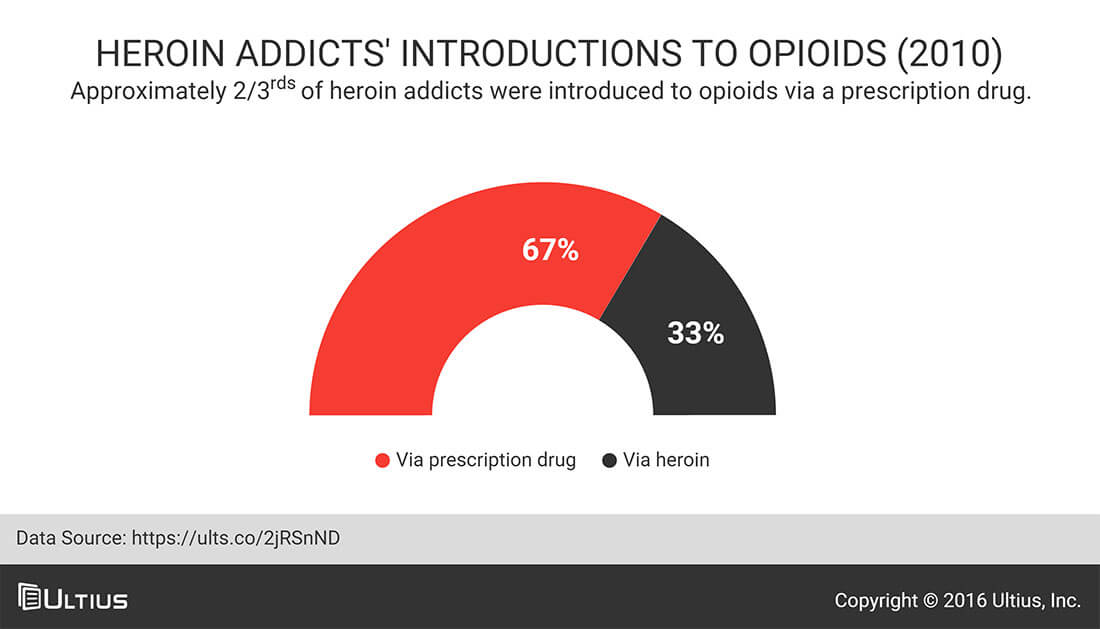
This means that a large number of Americans begin by abusing prescription opioids, and then end up switching over to heroin for whatever reason.
Heroin, a cheaper alternative to other drugs
One of the main reasons for this switch from prescription opioids (such as oxycontin) to heroin is that heroin is simply much cheaper than pharmaceutical drugs. Dr. Sanjay Gupta of CNN has written the following regarding this matter:
"Heroin is usually cheaper than prescription drugs. Opiate pain medications cost the uninsured about $1 per milligram; so a 60-milligram pill will cost $60. You can obtain the equivalent amount of heroin for about one-tenth the price."
The market itself simply drives opioid users to heroin. With everything else being equal other than price, anyone would naturally go for the cheaper of two similar products in any given area.
Effects of heroin
This emphasizes the point that the transition from prescription opioids to heroin is popular, because heroin does in fact produce effects that are similar to the pharmaceutical drugs. Both heroin and prescribed opioids are ultimately derived from the opium of the poppy plant. Dr. Stephen E. Lankenau of Drexel University told the New York Times that many opioid addicts tend to switch from heroin to oxycontin (and other prescription drugs) and back, depending on what is available and what they can afford at any given time.
Intake of heroin
It is also worth noting that the switch to heroin among opioid users is sometimes catalyzed by the fact that pharmaceutical companies have begun making it more difficult to get high on prescription opioids.
For example, The Food and Drug Administration (FDA) has indicated that there are certain controls being built into pills that make abusing them more difficult. This includes a measure that allows the chemicals to release gradually only when they are swallowed. This means that if opioid addicts wanted to get high, they would either need to get more creative about how they take in the pharmaceutical drugs, or they would need to switch over to unregulated heroin.

Patterns of personal drug use
The data cited above from the National Institute on Drug Abuse and other sources strongly indicate that this current generation of heroin users were turned on to the drug through the previous use of prescription pharmaceutical drugs. These latter drugs are prescribed by doctors to provide relief from some type of physical pain. These prescriptions are largely temporary, and are intended to be used within a certain time frame that corresponds with the patient’s pain.
Once a doctor determines there is no longer a need for a prescribed opioid, or treatment is complete, they will stop prescribing them. The problem arises when the patient still craves the “high” the pills provided, but no longer has access to them. It is in this stage that many current users of heroin and other opioids initially get hooked on the prescribed drugs, and may pursue alternative means to acquire them.
The evidence on this subject strongly supports this notion. Among nonmedical users of opioids, a prescription from one or more physicians is one of the most prevalent routes of access that were reported, second only to being given the drug for free by friends or relatives. And for consistent, everyday users of opioids, a prescription from a physician is actually the leading route of access and supply.
This data has been reported by the Centers for Disease Control and Prevention on the basis of research published in the Journal of the American Medical Association.
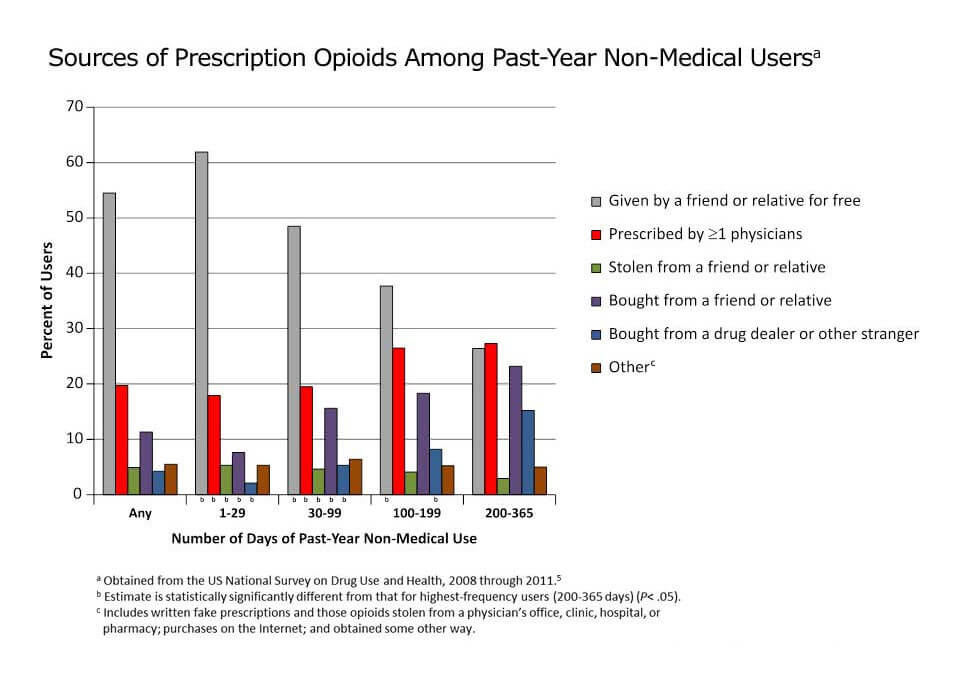
If an opioid user gets his drug(s) from friends or relatives either for money or for free, it is likely said friend/relative has a prescription from a doctor for the drug. It’s in this case that the friend/relative either no longer needs the medication, and has chosen to give it away to others, or perhaps decided to sell it. While the resale of prescription medication is obviously illegal, so is giving it away for free.
Demographic data of drug users
Two specific populations that are especially being affected by the current opioid abuse epidemic are adolescents (ages 12 to 17) and women. According to the American Society of Addiction Medicine, there were 467,000 adolescent nonmedical users of opioids in the year 2014. This organization has written the following regarding opioids and women:
"Women are more likely to have chronic pain, be prescribed prescription pain relievers, be given higher doses, and use them for longer time periods than men. Women may become dependent on prescription pain relievers more quickly than men."
In terms of race, it would seem that the opioid addiction epidemic is actually affecting Whites more significantly than it is minority populations such as Blacks or Hispanics. This is a relatively anomalous trend when it comes to drug abuse. Steven Ross Johnson, writing for Modern Healthcare, has indicated that this may because of racial bias in the prescription of opioids: physicians are in general more reluctant to prescribe opioids to minority patients, because they tend to think that minority patients may be more susceptible to addiction and/or selling the medication on the black market.
Reasons for popularity (compared to alcohol)
Opioids, of course, are not the only class of drugs that are abused by Americans. For example, the National Institute on Alcohol Abuse and Alcoholism has indicated that in the year 2014, a total of about 17 million Americans had alcohol use disorder (more commonly known as alcoholism). This is greater than the number of Americans abusing opioids by a factor of about 8.5—meaning, there are 8.5 times as many alcoholics in America as there are opioid addicts. And of course, alcohol is a perfectly legal drug.
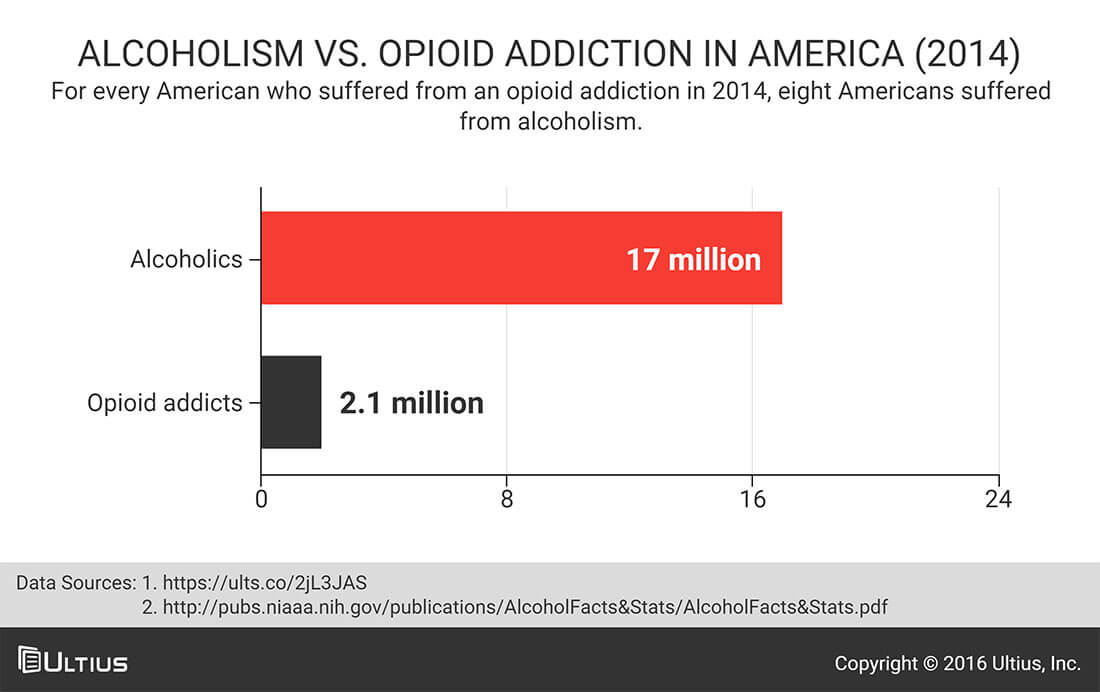
What these numbers indicate is although opioid abuse is surely a serious issue, it is also important to maintain a sense of scale or proportion regarding the issue. It is not as though this is the only drug abuse problem facing the United States.
The appeal of opioids
It is nevertheless true that opioids in particular have a special appeal for a good number of people. The obvious reason for this could just be traced back to the drug’s euphoric effects. After all, the name "laudanum" is derived from a root Latin verb that means "to praise;" and when morphine was discovered, it was named after Morpheus, the ancient Greek god of dreams. The only conclusion that can be drawn, is that at least in the short run, the effects of opioids are highly pleasurable for human beings.

Essentially, opioids—and especially heroin—produce a huge endorphin and dopamine rush that hit the brain fast, and they also block off any signals of pain from being registered by the brain. It is this mix of greatly enhanced pleasure and greatly reduced pain that leads people to seek out opioids and keeps them coming back for more of the drugs.
If opioids have become a national problem, then this likely due to the market being flooded with them. It is not as though a lot of people just suddenly realized that they want to feel the rush of opioids. Rather, the issue is that opioids are now far more readily available, and people have much greater opportunity for getting turned on to them. This will be further elaborated on a little later in this article.
Responses to the problem
At the present time, it would seem that the federal government is only at the initial phases of developing a concerted response to the problem of the opioid abuse epidemic. According to Nora D. Volkow of the National Institute on Drug Abuse, one of the main efforts in this area has consisted of developing new pain relief medications (also known as analgesics) that will deliver the desired results but have less potential for generating opioid addiction.
The word "analgesic" is an umbrella term for any drug that produces the effect of pain relief. These drugs work by blocking pain receptors within the brain. Historically, opioids have been the most popular and effective form of analgesic. In principle, though, it should be possible to develop other drugs that have the same pain relief effects as opioids but less addictive potential.
Under public and governmental pressure, pharmaceutical companies have also begun manufacturing drugs that have been labeled as abuse-deterrent by the Food and Drug Administration. This is how the agency describes these new products:
"Formulations with abuse-deterrent properties target the known or expected routes of abuse, such as crushing in order to snort or dissolving in order to inject, for the specific opioid drug substance."
The idea here is that when the prescription drugs are manipulated in a way that will lend them to abuse, they will deactivate the relevant active chemicals so that abuse is no longer possible.
Response to opioid abuse at the local level
At the local level, the main priorities regarding opioid abuse would seem to be:
- Working toward public education about the risks inherent in the use of opioids and their high potential for addiction.
- Develop awareness among both healthcare and law enforcement professionals regarding the ways in which the problem is affecting the community.
These main points emerge in various brief reports found on the Internet regarding responses to the opioid abuse epidemic across several individual states, including Maryland, Massachusetts, and Nebraska. In general, it can be suggested that formal responses to the opioid abuse epidemic, at both the federal and the local levels, are only at the early stages of formulation. It is only recently that the magnitude of the problem and the need for a concerted policy response has become clear to all.
Treatment initiatives
There are three main treatment initiatives that have emerged in response to the opioid abuse epidemic within the United States. These are: the opioid overdose prevention toolkit, Good Samaritan laws, and the drug Naloxone. It is worth discussing each of these in turn.
Overdose prevention toolkit
The toolkit is essentially a packet of information distributed by agencies regarding what various stakeholders should do in the event that an instance of opioid overdose occurs in their presence. The Substance Abuse and Mental Health Services Administration (SAMHSA), for example, has provided one such toolkit. Here is a screenshot of its table of contents:
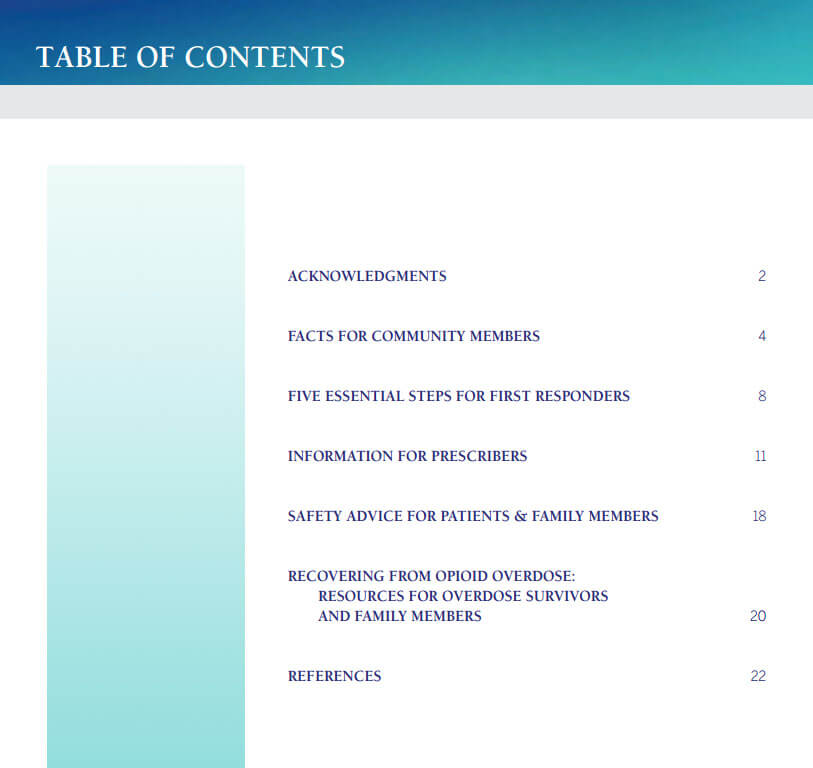
The diversity of stakeholders covered by the information in the toolkit is characteristic of this form of treatment initiative.
Good Samaritan laws
In general, a Good Samaritan law is a legal provision that grants immunity to a person who calls help for someone else in danger, in the event that calling for help would make that person liable of a crime or violation in some way. For example, if the right conditions are met, then someone who calls 911 because his friend is suffering from a heroin overdose may be granted immunity against legal charges for possessing heroin himself.
Several states within the nation have Good Samaritan laws on the books regarding drug overdose.
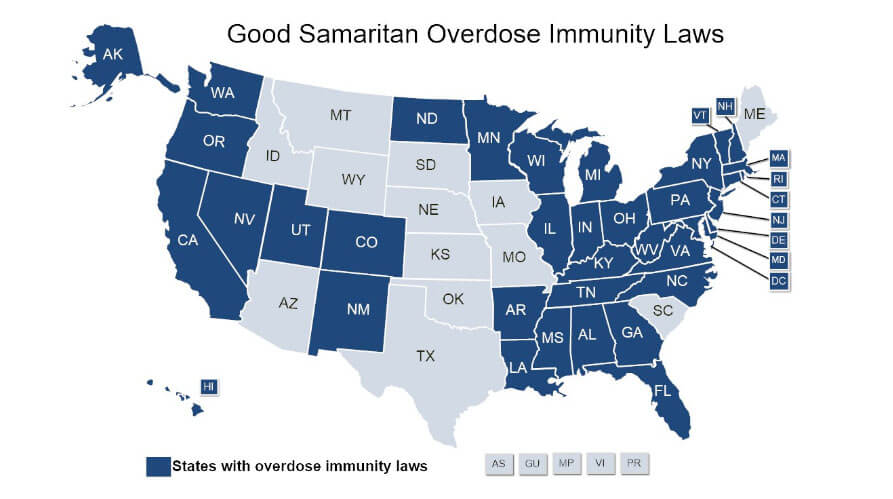
Some states are taking a completely opposite approach. These jurisdictions are enacting laws that hold facilitators of an overdose death (e.g., a friend of a heroin addict who ties a belt around his arm) guilty of being an accomplice to murder. The hope with these laws are that they may discourage people from participating in a situation in which a drug overdose may occur. Such laws may complement Good Samaritan laws in some states.
Naloxone/Narcan
Naloxone is a drug that can reverse the immediate life-threatening effects of opioid overdose. According to the National Office on Drug Control Policy, first responders (such as police officers) are urged to carry this drug with them in areas where opioid abuse is rampant, due to the fact that the quick administration of naloxone could save the lives of people who are experiencing opioid overdose.
Unfortunately, very few states within the nation currently have laws that enable access naloxone without incurring legal liability within the situation of drug overdose, while other states and cities such as Boston provide training to emergency responders as well as the general public on how to administer the drug in the event of an overdose.
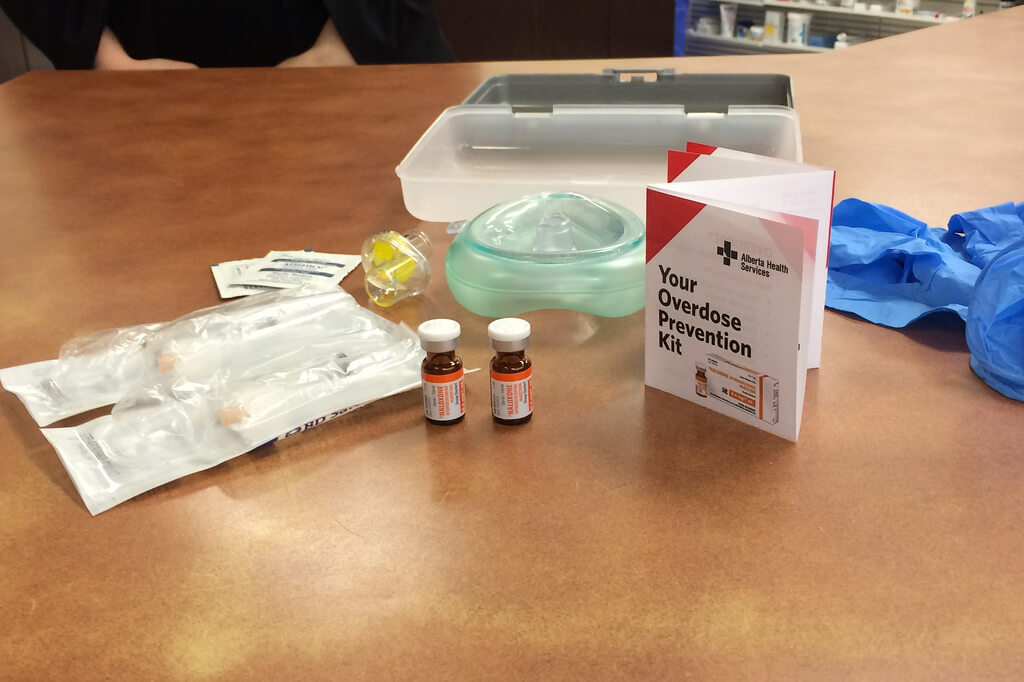
Evaluating the larger issue
All of these efforts surely do more good than harm. However, it is also a fact that the opioid epidemic is still a major issue within the nation, despite such efforts. This may be a case of time: concerted responses to the problem are relatively recent, and they may become more effective as the months and years pass.
There is also reason to believe that there are underlying structural factors driving the epidemic that need to be addressed, and the secondary treatment initiatives discussed above may ultimately prove inadequate with respect to really getting to the root of the problem.
Opioids in jails and prisons
A significant correlation can be found between opioid abuse on one hand and incarcerated status on the other: opioids are very popular among people in jail/prison.
According to an article published by Shannon Gwin Mitchell et al. in the Journal of Psychoactive Drugs, about 15 percent of all the people entering American jails and prisons in a given year are addicted to heroin.
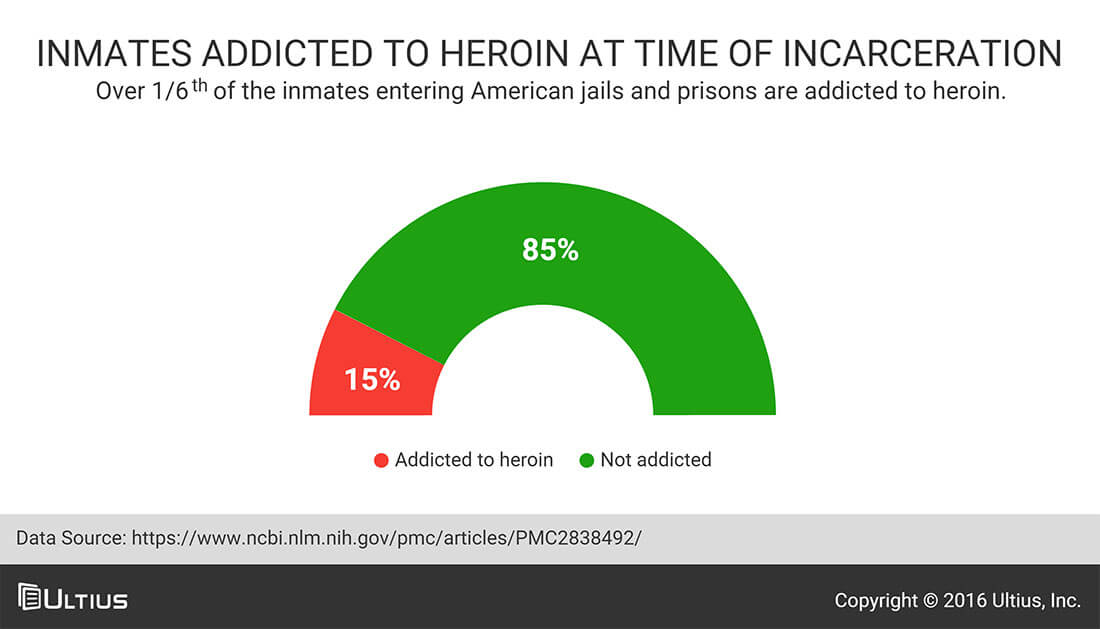
This is a huge number, given that only about 0.6 percent of Americans in general are abusing opioids of any kind: a percentage so small, it would not even show up in a pie chart comparison. This is especially troubling in states with mandatory minimum sentencing laws. These laws dictate that offenders, even non-violent drug offenders, spend a mandatory amount of time incarcerated. This often leads to even further drug abuse as the offender has a difficult time finding employment, or getting their life back on track in general due to having a criminal record.
A new treatment offers hope
In the Kenton County jail, located in Kentucky, officials are using a drug called Vivitrol to help cut back on addiction, and rates of incarceration. According to the drug’s official website, Vivitrol works by blocking the pleasure receptors in the brain associated with opioids but the effects of the drug decrease, and eventually go away over the course of about 30 days.
To combat addiction and the amount of inmates returning to jail, Kenton County jail officials are administering Vivitrol to inmates once they're released from jail, and allowing released inmates to return once a month to receive another dose in hopes to kick opioid addiction for good.
Jason Merrick, a former inmate and addict himself, started the Vivitrol treatment in the jail. Merrick says inmates who don’t receive the treatment have a 70 percent chance of being arrested and returning to jail. Conversely, for inmates who do receive the treatment, that return rate drops to just 10 percent.
Methadone treatment
The article by Shannon Gwin Mitchell et al. has also indicated that many inmates may have been cut off from their methadone treatment programs when they were admitted to jail or prison. These programs give heroin addicts the drug methadone as a way of helping the patients wean themselves away from their primary addiction.
When these patients are abruptly thrown into jail/prison, they will face the full effects of opioid withdrawal without any help at all (and this is also true, of course, of the heroin addicts who were not in any form of treatment program prior to incarceration). This can create a huge demand from all these people in pain within prison walls for a supply of opioids. And where there is a demand, supply tends to materialize, through one avenue or another.
Potential solutions
One solution for the problem of the prevalence of opioid abuse within jails/prisons would be to simply not incarcerate opioid abusers in the first place, but rather treat them as people with mental health issues who need the relevant kind of help. This would obviously be a very different paradigm from the dominant mentality of treating opioid abusers as outright criminals.
| Criminal issue | Mental health issue |
|
|
Moreover, in the event that opioid addicts do continue getting incarcerated, jail/prison officials could work toward treating their health issues, as opposed to just letting them suffer. This may decrease the impulse among inmates to find opioids on the black market.
Role of drug manufacturers
It is undeniable that drug manufacturers have played an enormous role in catalyzing and supporting the opioid abuse epidemic. This is because pharmaceutical companies have a huge economic self-interest in having as many people as possible buy their painkillers.
This is, after all, the nature of business: the more people who buy one's products, the better. This has often led pharmaceutical companies to dissemble the actual facts regarding their opioid products and the potential that those products have for addiction and abuse.
Purposely providing misleading information
For example, in the 1990s, back when general opinion was first turning in favor of opioids, Purdue Pharma—a leading producer of opioid medications, made ads featuring inspirational personal stories and put out claims such as that the rate of patients getting addicted to opioids is actually less than 1 percent (Art Van Zee, in an article published in the American Journal of Public Health).
In retrospect, this would seem to be obviously false and misleading. The opioid abuse epidemic at the present time is evidence that the addiction potential for opioid medications was clearly far greater than what was reported by Purdue Pharma. In fact, Purdue Pharma itself conceded as much in the year 2007—after so much damage had already been done.
The pharmaceutical company was fined 624 million dollars for charges of misleading marketing and lying to the public about the nature and dangers of opioid medications.
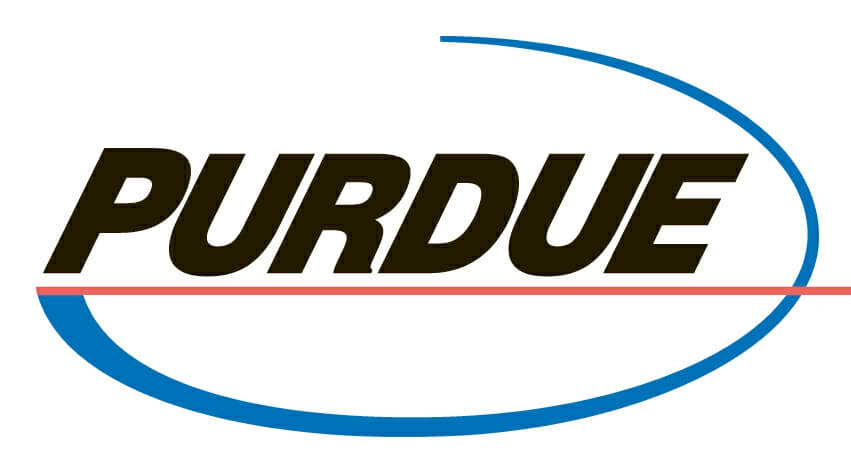
Purdue Pharma was not alone in this. Rather, they were part of a broader narrative regarding opioid medications that was being propagated by several pharmaceutical companies.
Value of medication
All this discussion of the dangers of opioid medications, and the false statements by pharmaceutical companies regarding those dangers, should not lead us to ignore the fact that the medications do exist for a legitimate purpose. Part of the reason for the resurgence of these drugs in the 1990s was that the public genuinely did realize that opioids provide real relief to people suffering from severe chronic pain, such as patients who are in late-stage cancer.
This means that the answer cannot consist of simply getting rid of opioid medications altogether. Rather, the answer must involve developing more responsible opioid prescription practices, which take into account the real dangers of the medications and ensure that only those patients who truly need the medications are getting prescriptions for them. It also means insurance companies, and physicians should explore all options before prescribing them, such as prescribing medical marijuana for patients who don’t need or don’t want an opioid derived medication.
Physicians being paid to play along
Another aspect of the opioid abuse epidemic pertains to collusion that may be occurring between pharmaceutical companies and prescribing physicians.
Important definition: Collusion—a secret conspiracy or partnership between two or more stakeholders that is designed to cheat or manipulate other stakeholders.
The idea here is that physicians may face pressures or incentives to prescribe more opioids than they otherwise might on the basis of strictly evidence-based and scientific considerations.
A prime example of pay for play
It is not uncommon for pharmaceutical companies to have physicians on their payrolls in order to make their products more acceptable within the medical profession. On his show Last Week Tonight, John Oliver presents a clip of one such physician in the year 1998 discussing opioid prescriptions by using the misleading term “pseudo-addiction” in the following way:
"When a patient is looking like a drug addict because they are pursuing pain relief: so, pseudo-addiction is relief-seeking behavior that is mistaken as drug addiction."
This statement obviously makes no sense whatsoever, and is nothing more than simple deceit. The correct interpretation is that all drug addicts exhibit "relief-seeking behavior," and there is nothing "pseudo" about that at all. A substance user who is hooked on prescription opioids is just a simple drug addict, like anyone else. This physician clearly only had his own pay-for-play self-interest in mind.
Issue of insurance
Aside from cooperation between physicians and pharmaceutical companies, there may also be other structural factors within the healthcare system that contribute to the opioid abuse epidemic. For example, Harrison Jacobs of Business Insider has reported the following:
"Though the increased focus on pain treatment resulted in increases in opioid prescriptions in most doctors initially, for years now, specialists have advocated using alternative treatments to alleviate patients' chronic pain. There's one problem: Health-insurance companies are increasingly cutting reimbursements for these alternative treatments or not covering them at all."
This means that as a result of the financial structure of their medical practice, physicians may find themselves in a difficult position, where there are only three options on the table, none of them ideal:
- Have the patient pay out of pocket for potentially expensive treatments;
- Prescribe opioids and have the patient take his chances with addiction;
- Do nothing, and leave the patient's pain unmanaged.
This an example of the kind of logistical barrier that stands in the way of even the most ethical of physicians trying to do something to help with this epidemic of opioid use.
Healthcare lobbies
The structure of the American healthcare system and its financing depend on the laws of the nation. And in this context, it is perhaps worth saying a brief word about the pharmaceutical and health insurance lobbies that affect the laws that Congress passes regarding healthcare regulations, such as the Affordable Care Act, or Obamacare.
It is possible that such lobbies are engaged in collusion with each other, in a bid to keep the company's' profits up, even when this may produce results that are contrary to the best interests of the American people.
A moral responsibility
After this comprehensive discussion, the question can be asked: who is really responsible for the opioid abuse epidemic within the United States? And it would seem to be clear enough that there is no simple answer to this question.
In truth, most of the key stakeholders in this issue would seem to bear at least some responsibility for the problem. For example, pharmaceutical companies are clearly a part of the problem; but then, so is the broader economy that creates bad situations and environments for so many Americans, as well as the individual Americans themselves who succumb to opioid addiction.
| Party | Culpability |
| Pharmaceutical companies | Providing false information to the American people over time regarding the risks inherent in the use of prescription opioid medications |
| American government | Failing to regulate the economy in a way that provides good holistic environments for the lives of all Americans, especially those in rural areas |
| Individual Americans | Lacking the moral wherewithal to refuse to succumb to opioid addiction, regardless of the situations of their lives |
| Physicians | Giving the claims of pharmaceutical companies an air of professional legitimacy through their pay-for-play support |
| Healthcare lobbies | Advocating for policies that prevent physicians from pursuing alternative pain management modalities |
In short, the opioid abuse epidemic is a complex problem that has been fed by several factors and the decisions of various stakeholders. Doing something about the problem will thus require a holistic and cooperative effort that can counteract all of the roots that have given rise to the problem in the first place.
Key takeaways
The last question that must be answered here now is: what must be done, and is there hope for the future? To answer this question, it is first of all important to keep a sense of proportion. While it is true that the opioid abuse epidemic is a serious problem, it is also true that this is only one part of Americans' more general problem with substance abuse, and that in terms of sheer numbers, relatively few Americans are actually hooked on opioids.
There are thus two main avenues that must be pursued when addressing this problem. The first consists of the over-prescription of opioids. If this continues, it may lead Americans who are otherwise uninterested in drugs to become unwittingly addicted to their pain medications. The second has to do with the pharmaceutical companies and the prescription practices of physicians. Addressing it will require reform within the inner workings of the healthcare system as a whole.
Despair, revisited
It is also important to analyze the underlying reasons why Americans may choose to pursue a life of drug use in the first place. This generally has to do with the problem of despair, or hopelessness. Not to mention all the pitfalls of once someone is actually addicted. As mentioned in a previous blog post from Ultius, the world of addiction is not a pretty one, and can negatively impact your career, marriage, and other aspects of one’s life.
As stated above in this article, the vast majority of economic activity within the United States is concentrated within a small minority of counties; and the counties with low economic activity, which are largely rural in nature, are also the places where the opioid epidemic within the nation has taken the strongest root.
This points toward a problem that is economic, cultural, and social all at once. Drug abuse is generally a sign that people do not feel that they are any longer a valuable part of their society or their community—that they have in some way been left behind, and that the possibilities for their lives have been foreclosed upon. This a macro-level factor that influences not just opioid addiction but drug addiction in general, and it would seem that a wide-ranging societal and cultural transformation would be needed in order to truly get to the bottom of this matter.
Works Cited
American Society of Addiction Medicine. "Opioid Addiction: 2016 Facts and Figures." Author, 2016. Web. 2 Dec. 2016.
<http://www.asam.org/docs/default-source/advocacy/opioid-addiction-disease-facts-figures.pdf>.
Centers for Disease Control and Prevention. "Prescribing Data." Author, 2016. Web. 2 Dec. 2016.
<http://www.cdc.gov/drugoverdose/data/prescribing.html>.
Food and Drug Administration. "FDA Facts: Abuse-Deterrent Opioid Medications." Author, 2016. Web. 2 Dec. 2016.
<http://www.fda.gov/NewsEvents/Newsroom/FactSheets/ucm514939.htm>.
Gupta, Sanjay. "Unintended Consequences: Why Painkiller Addicts Turn to Heroin." CNN. 2 Jun. 2016. Web. 2 Dec. 2016.
<http://www.cnn.com/2014/08/29/health/gupta-unintended-consequences/>.
Keyes, Katherine M., Magdalena Cérda, Joanne E. Brady, Jennifer R. Havens, and Sandro Galea. "Nonmedical Prescription Opioid Use and Abuse in the United States." American Journal of Public Health 104.2 (2014): e52-e59. Web. 2 Dec. 2016.
<http://www.medscape.com/viewarticle/819985>.
Jacobs, Harrison. "Pain Doctors: Insurance Companies Won't Cover the Alternatives to Opioids." Business Insider. 10 Aug. 2016. Web. 5 Dec. 2016.
<http://www.businessinsider.com/doctors-insurance-companies-policies-opioid-use-2016-6>.
Johnson, Steven Ross. "The Racial Divide in the Opioid Epidemic." Modern Healthcare. 27 Feb. 2016. Web. 2 Dec. 2016.
<http://www.modernhealthcare.com/article/20160227/MAGAZINE/302279871>.
Leger, Donna Leinwand. "OxyContin Is a Gateway to Heroin for Upper-Income Addicts." USA Today. 28 Jun. 2013. Web. 2 Dec. 2016.
<http://www.usatoday.com/story/news/nation/2013/04/15/heroin-crackdown-oxycodone-hydrocodone/1963123/>.
Mitchell, Shannon Gwin, et al. "Incarceration and Opioid Withdrawal." Journal of Psychoactive Drugs 41.2 (2009): 145-152. Web. 5 Dec. 2016.
<https://www.ncbi.nlm.nih.gov/pmc/articles/PMC2838492/>.
National Institute on Alcohol Abuse and Alcoholism. "Alcohol Facts and Statistics." Author, 2016. Web. 2 Dec. 2016.
<http://pubs.niaaa.nih.gov/publications/AlcoholFacts&Stats/AlcoholFacts&Stats.pdf>.
National Institute on Drug Abuse. "Prescription Opioids and Heroin." Author, 2015. Web. 2 Dec. 2016.
<https://www.drugabuse.gov/publications/research-reports/relationship-between-prescription-drug-heroin-abuse/prescription-opioid-use-risk-factor-heroin-use>.
National Office on Drug Control Policy. "Fact Sheet: Opioid Abuse in the United States." Author, 11 Feb. 2014. Web. 5 Dec. 2016.
<https://www.whitehouse.gov/sites/default/files/ondcp/Fact_Sheets/opioids_fact_sheet.pdf>
Oliver, John. "Opioid Abuse." Last Week Tonight. HBO, 23 Oct. 2016. TV Show.
<https://www.youtube.com/watch?v=5pdPrQFjo2o&t=885s>
Purdue Pharma. “A Brief History of Opioids.” The Atlantic. 2014. Web. 1 Dec. 2016.
<http://www.theatlantic.com/sponsored/purdue-health/a-brief-history-of-opioids/184/>.
Substance Abuse and Mental Health Services Administration. "A Comparison of Rural and Urban Substance Abuse Treatment Admissions." The Teds Report. 31 Jul. 2012. Web. 2 Dec. 2016.
<http://www.samhsa.gov/sites/default/files/teds-short-report043-urban-rural-admissions-2012.pdf>.
Substance Abuse and Mental Health Services Administration. SAMHSA Opioid Overdose Toolkit. 2014. Web. 5 Dec. 2016.
<https://store.samhsa.gov/shin/content/SMA13-4742/Overdose_Toolkit_2014_Jan.pdf>.
Tankersley, Jim. "Donald Trump Lost Most of the American Economy in This Election." Washington Post. 22 Nov. 2016. Web. 2 Dec. 2016.
<https://www.washingtonpost.com/news/wonk/wp/2016/11/22/donald-trump-lost-most-of-the-american-economy-in-this-election/?utm_term=.9236eb978a89>.
Volkow, Nora D. “American’s Addiction to Opioids: Heroin and Prescription Drug Abuse." National Institute on Drug Abuse, 14 Mar. 2014. Web. 1 Dec. 2016.
<https://www.drugabuse.gov/about-nida/legislative-activities/testimony-to-congress/2016/americas-addiction-to-opioids-heroin-prescription-drug-abuse>.
Volkow, Nora D. "What Is the Federal Government Doing to Combat the Opioid Abuse Epidemic." National Institute on Drug Abuse, 1 May 2015. Web. 2 Dec. 2016.
<https://www.drugabuse.gov/about-nida/legislative-activities/testimony-to-congress/2016/what-federal-government-doing-to-combat-opioid-abuse-epidemic>.
Zee, Art Van. "The Promotion and Marketing of OxyContin." American Journal of Public Health 99.2 (2009). Web. 7 Dec. 2016.
<https://www.ncbi.nlm.nih.gov/pmc/articles/PMC2622774/>.
Gieringer, Dale. “125th Anniversary of the First U.S. Anti-Drug Law: San Francisco's Opium Den Ordinance” Drugsense.org. Nov. 2000.
<http://www.drugsense.org/dpfca/opiumlaw.html>
Benedict, Carey. “Prescription Painkillers Seen as a Gateway to Heroin” The New York Times. Web. 10 Feb. 2014.
<https://www.nytimes.com/2014/02/11/health/prescription-painkillers-seen-as-a-gateway-to-heroin.html?_r=0>
Axelrod, Jim. “Kentucky jail using new drug treatment for inmates addicted to opioids” cbsnews.com. CBS NEWS. Web. 19 Oct. 2016
<http://www.cbsnews.com/news/kentucky-jail-pioneering-treatment-for-inmates-addicted-to-oipoids/>
- MLA Style
- APA Style
- Chicago Style
- Turabian
Ultius, Inc. "A Look Inside the Growing Problem of Opioid Addiction in the United States." Ultius | Custom Writing and Editing Services. Ultius Blog, 09 Feb. 2017. https://www.ultius.com/ultius-blog/entry/a-look-inside-the-growing-problem-of-opioid-addiction-in-the-united-states.html
Copied to clipboard
Click here for more help with MLA citations.
Ultius, Inc. (2017, February 09). A Look Inside the Growing Problem of Opioid Addiction in the United States. Retrieved from Ultius | Custom Writing and Editing Services, https://www.ultius.com/ultius-blog/entry/a-look-inside-the-growing-problem-of-opioid-addiction-in-the-united-states.html
Copied to clipboard
Click here for more help with APA citations.
Ultius, Inc. "A Look Inside the Growing Problem of Opioid Addiction in the United States." Ultius | Custom Writing and Editing Services. February 09, 2017 https://www.ultius.com/ultius-blog/entry/a-look-inside-the-growing-problem-of-opioid-addiction-in-the-united-states.html.
Copied to clipboard
Click here for more help with CMS citations.
Ultius, Inc. "A Look Inside the Growing Problem of Opioid Addiction in the United States." Ultius | Custom Writing and Editing Services. February 09, 2017 https://www.ultius.com/ultius-blog/entry/a-look-inside-the-growing-problem-of-opioid-addiction-in-the-united-states.html.
Copied to clipboard
Click here for more help with Turabian citations.



